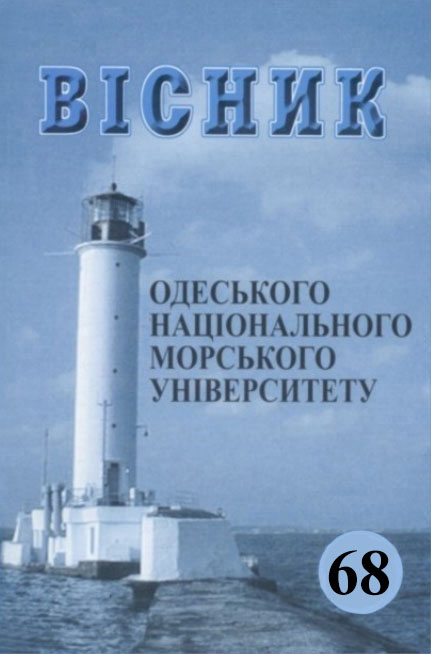Astronomical methods in maritime navigation. Relevance and ways of improvement
Main Article Content
Abstract
The navigational safety of a vessel depends to a large extent on the frequency and accuracy of the vessel positioning procedure. In the open sea, when there are no visual landmarks, this task has been most often solved by navigators in recent years with the help of global navigation satellite systems (GNSS), primarily GPS. However, despite the great advantages over the classical methods of determining the vessel's position, the use of GNSS carries significant risks, especially in the context of an aggravated military and political situation and military operations in the areas of navigation. In these conditions, the use of astronomical methods of ship location becomes relevant because they are autonomous. There are practically no means to deprive a ship of the possibility of astronomical observations in case of failure of electrical equipment; celestial bodies are natural navigation sensors, which allows simultaneous measurements to calculate elements of several isolines; celestial bodies provide the ability to determine the coordinates of a ship in any part of the world ocean; there are no other methods than astronomical ones to determine the correction of the direction indicator in the open sea. At the same time, classical astronomical methods of vessel positioning have some limitations related to meteorological conditions, insufficient speed and accuracy of processing the initial data and performing mathematical calculations, which, in particular, is related to the level of professionalism of the person performing the relevant procedures. One of the ways to resolve these contradictions is to introduce the synthesis of a unified software package for a personal computer, a methodology for planning astronomical observations using a personal computer, modern automated optical instruments, the development of planning algorithms and their organic inclusion in a unified software package of astronomical navigation methods, as well as the development of control and training programmes in navigational astronomy aimed at the An example of the practical implementation of this complex can be a laboratory and training complex for «Nautical Astronomy», which allows to conduct training and research regardless of weather conditions and geographical location.
Article Details
References
2. Danylenko O.B. Aktualnist ta shliakhy rozvytku kompetentnosnykh yakostei sudnovodiiv u zastosuvanni astronomichnykh metodiv navihatsii. Innovatsiini pidkhody do rozvytku kompetentnisnykh yakostei fakhivtsiv v umovakh profesiinoho stanovlennia: materialy VI Mizhn.nauk.-prakt. konf. Izmail, 21 kvitnia 2022 r. Zaporizhzhia: AA Tandem, 2022. 399 s.
3. Danylenko O.B. Neperervna profesiina pidhotovka maibutnikh sudnovodiiv u vyshchykh morskykh navchalnykh zakladakh: teoriia i praktyka : monohrafiia. Zaporizhzhia: AA Tandem, 2020. 564 s.
4. Myshchyk N. Tselostno-systemnыi analyz parallaktycheskoho treuholnyka morekhodnoi astronomy. Budapest, Hungary: http://www.scientificheritage.com/wp-content/uploads/2021/10/The-scientific-heritage-No-75-75-2021-Vol-1.pdf No 75 (2021) 10
5. Startsev O.M. Vykorystannia trenazheriv shchodo nadbannia kompetentnostei z mistseznakhodzhennia sudna astronomichnymy sposobamy. Innovatsiini pidkhody do rozvytku kompetentnisnykh yakostei fakhivtsiv v umovakh profesiinoho stanovlennia: materialy VI Mizhn.nauk.-prakt. konf. Izmail, 21 kvitnia 2022 r. Zaporizhzhia: AA Tandem, 2022. 399 s.
6. Fohylev V. Analytycheskye metodы obrabotky y tochnost astronavygatsyonnikh observatsyi. Avtoreferat dyssertatsyy na soyskanye uchenoi steneny kandydata tekhnycheskykh nauk. Sankt-Peterburh – 2012. Otpechatano s hotovogo orygynal-maketa, predostavlennogo avtorom, v typografy Yzdatelstva Polytekhnycheskoho unyversyteta. Sankt-Peterburg, Polytekhnycheskaiaul.,29.
7. Cheroi L. Zastosuvannia innovatsiinykh tekhnolohii navchannia pid chas vykladannia «Morekhidnoi astronomii» maibutnim sudnovodiiam // Zb. nauk. prats Natsionalnoi akademii derzhavnoi prykordonnoi sluzhby Ukrainy. Seriia: pedahohichni nauky. Khmelnytskyi: Vyd-vo NADPSU im. B. Khmelnytskoho. Tom 25. № 2 (2021).
8. Veb-sait. URL: https://naukarus.com/k-voprosu-o-primenenii-morehod-noyastronomii-v-sovremennoy-praktike-moreplavaniya (data zvernennia 15.02.2022).
9. Veb-sait. URL: https://www.100rmsim.ru/catalog/morskoy_transport/2941/ (data zvernennia 15.02.2022).
10. Veb-sait. https://zora.ru/?page_id=413 (data zvernennia 15.02.2022).
11. Veb-sait. https://studfile.net/preview/5156706/page:14/ (data zvernennia 15.02.2022).
12. Veb-sait. URL: https://zakon.rada.gov.ua/laws/show/896_052#Text (data zvernennia 15.02.2022).
